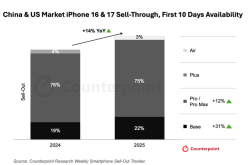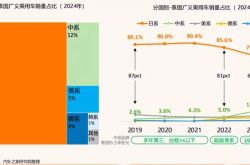From 'Tech Pioneer' to 'Commercial Dilemma': Alibaba Cloud's Unfinished Transformation Journey
![]() 05/06 2025
05/06 2025
![]() 1019
1019
In 2024, the global cloud computing market surpassed $1.2 trillion, with China leading the charge at a 25% growth rate. Alibaba Cloud secured the third position globally, boasting a 12% market share and a dominant 38% share in the Asia-Pacific region. Its annual revenue exceeded 120 billion yuan, marking a 28% year-on-year increase. According to its financial report, the government and enterprise market accounted for over 40% of its revenue for the first time, with customer renewal rates surpassing 85% for core products such as Elastic Compute Service (ECS) and database services. Leveraging the 'Apsara + DingTalk' strategy and the large-scale commercialization of its self-developed 'Yitian 710' chip, Alibaba Cloud appears poised to achieve its goal of becoming a 'full-stack service provider'.

However, beneath this surface of success lies turbulence. Despite surpassing the global industry average in revenue growth (20%), its operating margin dropped from 11% in 2023 to 7%, and the growth rate of its core public cloud business slowed to 15%, trailing behind Huawei Cloud (25%) and Tencent Cloud (18%). More critically, its international business was impacted by geopolitical factors, being overtaken by AWS in the Southeast Asian market, with European revenue declining 8% year-on-year. As 'price wars' and 'compliance risks' take their toll, this pioneer of Chinese cloud computing finds itself at a crossroads between technological ambition and commercial reality.
Moat or Mirage?
Alibaba Cloud's ascent is a microcosm of China's internet technology autonomy. In 2024, it held a 34% share of the domestic public cloud market, significantly ahead of Huawei Cloud (19%) and Tencent Cloud (16%). Its core competitiveness rests on three strategic pillars:
1. **Technological Accumulation for a Dimensional Advantage**
From the Apsara operating system to the Yitian 710 chip, Alibaba Cloud has cultivated a full-stack technological closed loop spanning from the underlying chip to the application layer over a decade. In 2024, its self-developed database PolarDB set a new record in the global TPC-C benchmark test, outperforming AWS Aurora by 40%; its edge computing nodes covered 30 countries worldwide, reducing latency to less than 15 milliseconds. A multinational retail enterprise that migrated to Alibaba Cloud reduced IT costs by 28% and increased order processing efficiency by 35%. This 'heavy technology' strategy has secured it a market share of over 47% in high-end sectors such as finance and government, making it an industry benchmark.
2. **Ecological Collaboration for Scale Effect**
Backed by the Alibaba Group, Alibaba Cloud has forged a super collaborative network of 'cloud + e-commerce + payment'. During the 'Double 11' shopping festival in 2024, its elastic scaling capabilities supported a peak transaction rate of 620,000 transactions per second, while Cainiao Networks reduced logistics costs by 14% through Alibaba Cloud's AI algorithms. More importantly, with over 700 million enterprise users on DingTalk, its 'Apsara + DingTalk' strategy elevated the gross margin of the PaaS layer to 68%, far exceeding the industry average of 52%. This ecological bundling has allowed Alibaba Cloud to thrive in the government and enterprise market; in a provincial government cloud project tender, Alibaba Cloud secured a 1.5 billion yuan order from Huawei Cloud with its 'Data Mid-platform + DingTalk OA' combined solution.
3. **Price Cutting for Aggressive Expansion**
'30% cheaper than Huawei Cloud, 25% cheaper than Tencent Cloud' - Alibaba Cloud's 2024 'Glacier Action' further lowered the industry's price baseline. Through large-scale procurement and cost dilution from self-developed chips, its Elastic Compute Service (ECS) prices fell by 19% compared to 2023, and its Object Storage Service (OSS) rates approached 75% of AWS S3's. The impact of this low-price strategy was immediate: the number of new small and medium-sized customers in the first quarter increased by 53% year-on-year, with 70% coming from former Tencent Cloud users. The founder of a startup admitted, 'Alibaba Cloud's first-year subsidies are sufficient to cover development costs. As for whether to renew in the second year? Let's see if we survive first.'
Close-Quarters Combat with Cloud Titans
The global cloud computing battlefield is no longer a one-dimensional competition of technology but a multifaceted struggle encompassing ecology, geopolitics, and strategic endurance. Alibaba Cloud's vaunted self-developed technology, under the 'full-stack crushing' and 'ecological encirclement' of its rivals, is revealing a critical generational gap. Technology may garner applause, but commercial victory always goes to those who harness 'systemic advantages'.
Leveraging its strengths in social media and gaming, Tencent Cloud has engaged in all-round competition with Alibaba Cloud. In the audio-video cloud sector, Tencent Cloud launched the TRTC real-time audio-video engine, offering ultra-low-latency, high-stability services for live streaming, video conferencing, and other scenarios. In 2024, it held a 41% share of the audio-video cloud market, trailing Alibaba Cloud by just 3 percentage points. Additionally, Tencent Cloud leveraged WeChat, WeChat Work, and other traffic entry points to penetrate cloud services into millions of small and medium-sized enterprises. In 2024, it launched the 'Thousand Sails Plan', providing free cloud resources to 100,000 small and medium-sized enterprises, achieving a 32% market share in this segment, surpassing Alibaba Cloud's 28%.

With its robust hardware capabilities and government and enterprise resources, Huawei Cloud has engaged in a fierce competition with Alibaba Cloud in ecological construction. Relying on its 'Kunpeng + Ascend' hardware ecosystem, Huawei Cloud has introduced high-performance computing, artificial intelligence, and other solutions. In 2024, it held a 38% share of the government and enterprise market, surpassing Alibaba Cloud's 35%. Furthermore, Huawei Cloud attracted a vast number of developers and partners through the 'Fertile Soil Plan', with the number of active users in its developer community exceeding 3 million, gradually narrowing the gap with Alibaba Cloud.
International cloud giants such as Amazon Web Services (AWS) and Microsoft Azure are employing the 'technology + localization' strategy to capture the Chinese market, impacting Alibaba Cloud's global market share. In 2024, AWS, through its joint venture with SinoNet, launched the fifth-generation EC2 instances in China, enhancing computing performance by 45%. Its 'Industry Solutions Store' listed over 1,500 industry applications spanning 10 major industries such as finance and healthcare. Microsoft Azure, with its globally leading AI technology and cloud computing services, has witnessed its market share in China steadily grow, reaching an 8% share of China's public cloud IaaS market in 2024, a 25% year-on-year increase.
Structural Challenges Beneath the Surface of Success
The more impressive Alibaba Cloud's financial report data appears, the more it resembles a gilded cage - externally adorned with the golden threads of 'market leadership,' yet internally beset with the loose ends of technological hollowing and strategic shortsightedness. As the industry celebrates the milestone of '120 billion yuan in revenue,' those in the know sneer: this is merely a numbers game, using short-term growth to mask long-term crises.
First, **The Collapse of the Security Myth**
The slogan 'China's safest cloud service' has been chanted for a decade, now reduced to ironic black humor. While other vendors view data security as a lifeline, Alibaba Cloud has turned compliance into a mere 'inspection-passing' business, with firewall rules riddled with vulnerabilities, permission management existing in name only, and security certifications becoming mere formalities. More alarmingly, in the face of frequent data breaches, its crisis PR jargon invariably revolves around 'strengthening internal rectification,' with the results of such rectifications often paving the way for the next round of incidents. When customers' core data is exposed in the cloud, the so-called 'technological moat' is revealed as nothing more than the Emperor's New Clothes.
Second, **Self-Destructive Price Wars**
Low-price dumping was originally a potent tool for territorial expansion, but when it becomes the sole means of competition, it morphs into a poison akin to drinking poison to quench thirst. Alibaba Cloud dragged the industry into a relentless internal struggle with the 'Glacier Action' but overlooked that cloud computing is not a fast-moving consumer good - customers seek a digital foundation they can trust with their lives and businesses, not a '9.9 yuan per year server.' When technological investment is squeezed by marketing budgets, when engineer culture is supplanted by sales KPIs, and when customers flee due to frequent service downtime caused by cheap services, this price carnival will inevitably lead to a value collapse across the entire industry.
Third, **The Closed Ecosystem's Fatal Arrogance**
The 'Alibaba Suite' was once a proud ecological trump card but has now become a self-imposed shackle. Forced bundling with DingTalk, hidden barriers in data interfaces, and open-source code packaged as proprietary rights... This closed-off approach may seem to lock in customers but actually stifles innovative vitality. As government and enterprise customers become wary of being 'Alibabafied,' as developers complain about 'higher adaptation costs than migration benefits,' and as international giants bypass Huawei Cloud to build open ecosystems, the walls Alibaba Cloud has erected in its closed kingdom will eventually trap itself in a maze.
Alibaba Cloud's dilemma underscores a collective delusion in China's cloud computing industry: can scale replace value? Can traffic obscure technology? As price wars descend into 'losing money to make a noise,' as security vulnerabilities erode customer trust, and as ecological closedness hinders innovation, this once industry leader may need a profound self-revolution.
Should it continue to indulge in the 'market share illusion,' using subsidy figures to whitewash technological hollowness? Or should it return to its original aspiration, placing heavy bets on core technology and an open ecosystem? The answer may lie in two paths: either reconstructing barriers through technology or achieving win-win outcomes through ecology.








